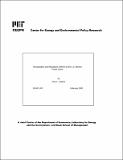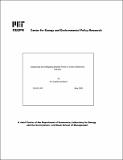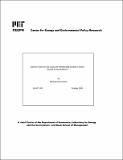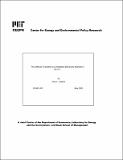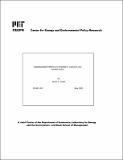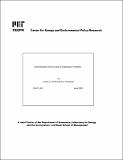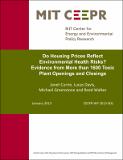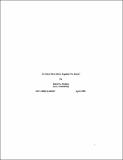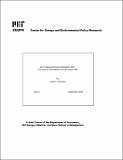Browsing Working Papers by Title
Now showing items 57-76 of 334
-
Crude oil supply curves
(MIT Center for Energy and Environmental Policy Research, 1998)Short-run cost curves shift over time as depletion counters increasing knowledge. Under competition, a rightward (leftward) shift indicates lower (higher) cost and greater (lesser) productivity. A simple coefficient captures ... -
Defensive Investments and the Demand for Air Quality: Evidence from the NOx Budget Program and Ozone Reductions
(MIT CEEPR, 2012-07)Willingness to pay for air quality is a function of health and the costly defensive investments that contribute to health, but there is little research assessing the empirical importance of defensive investments. The setting ... -
Deregulating and regulatory reform in the U.S. electric power sector
(MIT Center for Energy and Environmental Policy Research, 2000)This paper discusses the evolution of wholesale and retail competition in the U.S electricity sector and associated industry restructuring and regulatory reforms. It begins with a discussion of the industry structure and ... -
Deregulation in Japanese gas industries : significance and problems of gas rate deregulation for large industrial customers
(MIT Center for Energy and Environmental Policy Research, 1994)In recent years, the circumstances surrounding Japanese City gas industries have been changing drastically. On one hand, as energy suppliers, natural gas which has become major fuel resource for city gas, as public utilities, ... -
Designing a US Market for CO2
(2009)In this paper we focus on one component of the cap-and-trade system: the markets that arise for trading allowances after they have been allocated or auctioned. The efficient functioning of the market is key to the success ... -
Diagnosing and mitigating market power in Chile's electricity industry
(MIT Center for Energy and Environmental Policy Research, 2003)This paper examines the incentives to exercise market power that generators would face and the different strategies that they would follow if all electricity supplies in Chile were traded in an hourly-unregulated spot ... -
Did English generators play cournot? : capacity withholding in the electricity pool
(MIT Center for Energy and Environmental Policy Research, 2004)Electricity generators can raise the price of power by withholding their plant from the market. We discuss two ways in which this could have affected prices in the England and Wales Pool. Withholding low-cost capacity which ... -
Did the Clean Air Act cause the remarkable decline in sulfur dioxide concentrations?
(MIT Center for Energy and Environmental Policy Research, 2003)Over the last three decades, ambient concentrations of sulfur dioxide (SO2) air pollution have declined by approximately 80%. This paper tests whether the 1970 Clean Air Act and its subsequent amendments caused this decline. ... -
The difficult transition to competitive electricity markets in the U.S.
(MIT Center for Energy and Environmental Policy Research, 2003)This paper provides a comprehensive discussion of the causes and consequences of state and federal initiatives to introduce wholesale and retail competition into the U.S. electricity sector between 1995 and the present. ... -
Discounting rules for risky assets
(MIT Center for Energy and Environmental Policy Research, 1993)This paper develops a new rule for calculating the discount rate to value risky projects. The rule works under any linear asset pricing model and any equilibrium theory of debt and taxes. If securities are priced by the ... -
Distinguishable patterns of competition, collusion, and parallel action
(MIT Center for Energy and Environmental Policy Research, 2003)Alternative market structures are distinguishable by the degree of parallel action exhibited by producers. We show that the correlation between output levels varies systematically with the degree of interdependence among ... -
Diversification and the value of exploration portfolios
(MIT Center for Energy and Environmental Policy Research, 2005)Conventional wisdom holds that dependence among geological prospects increases exploration risk. However, dependence also creates the option to truncate exploration if early results are discouraging. We show that the value ... -
The diversity of design of TSOs
(MIT Center for Energy and Environmental Policy Research, 2008)It is puzzling today to explain diversity and imperfection of actual transmission monopoly designs in competitive electricity markets. We argue that transmission monopoly in competitive electricity markets has to be analysed ... -
Do Housing Prices Reflect Environmental Health Risks? Evidence from More than 1600 Toxic Plant Openings and Closings
(MIT CEEPR, 2012-01)A ubiquitous and largely unquestioned assumption in studies of housing markets is that there is perfect information about local amenities. This paper measures the housing market and health impacts of 1,600 openings and ... -
Do stock prices move together too much?
(MIT Center for Energy and Environmental Policy Research, 1990)We show that comovements of individual stock prices cannot be justified by economic fundamentals. This finding is a rejection of the present value model of security valuation. Unlike other tests of this model, ours is ... -
Do Trading and Power Operations Mix? The Case of Constellation Energy Group 2008
(2008)Constellation Energy has been a leading performer in the merchant power business since 2001. In addition to its legacy utility, Baltimore Gas and Electric, Constellation is a merchant generator and a wholesale power marketer ... -
Does competition reduce costs? : assessing the impact of regulatory restructuring on U.S. electric generation efficiency
(MIT Center for Energy and Environmental Policy Research, 2004)Although the allocative efficiency benefits of competition are a tenet of microeconomic theory, the relation between competition and technical efficiency is less well understood. Neoclassical models of profit-maximization ... -
Does hazardous water matter? : evidence from the housing market and the Superfund program
(MIT Center for Energy and Environmental Policy Research, 2006)This paper uses the housing market to develop estimates of the local welfare impacts of Superfund sponsored clean-ups of hazardous waste sites. We show that if consumers value the clean-ups, then the hedonic model predicts ... -
The Dynamic Effects of Hurricanes in the US: The Role of Non-Disaster Transfer Payments
(MIT Center for Energy and Environmental Policy Research, 2011-05)We know little about the dynamic economic impacts of natural disasters. I examine the effect of hurricanes on US counties’ economies 0-10 years after landfall. Overall, I find no substantial changes in county population, ... -
The dynamics of commodity spot and futures markets
(MIT Center for Energy and Environmental Policy Research, 2001)I discuss the short-run dynamics of commodity prices, production, and inventories, as well as the sources and effects of market volatility. I explain how prices, rates of production, and inventory levels are interrelated, ...



